
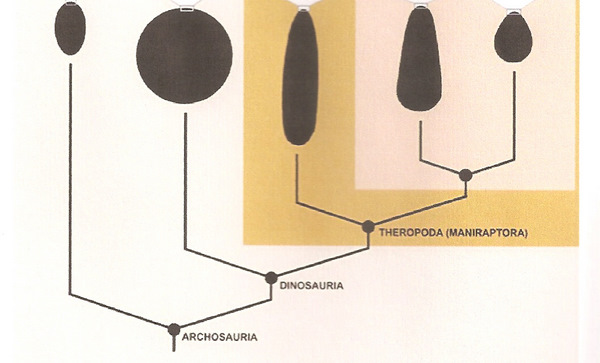
The dinosaur and theropod ancestors of birds were building nests in the early Jurassic
and even the late Triassic. This indicates that the even the earliest birds built nests to protect their eggs and young (From: Chiappe 2009).
Avian Reproduction: Nests
Birds use nests to protect eggs and nestlings from predators
and adverse weather. To minimize predation, birds may use or build nests
that are inaccessible, hidden, or camouflaged. Nests may also help keep
eggs and nestlings warm.
  The dinosaur and theropod ancestors of birds were building nests in the early Jurassic and even the late Triassic. This indicates that the even the earliest birds built nests to protect their eggs and young (From: Chiappe 2009). |
| Orientation and microclimate of Horned
Lark nests -- Across their range, Horned Larks
typically construct nests adjacent to & north of objects such as a
tuft of grass or a rock. Hartman and Oring (2003) studied the importance
of nest orientation to nest microclimate in Horned Larks in California.
Nests showed a significant northern bias in orientation angle and were
49% shaded in the early afternoon, the hottest part of the day. Artificial
nests of eastern, western, and southern orientations exhibited little to
no shade during this time. A northern nest orientation ensures maximal
shading by the grass tuft to the south, may protect nests from cool evening
winds, and provides increased daytime ventilation of the nest through exposure
to prevailing winds. In addition, shade may also help conceal nests from
predators.
|

The position of vegetation (curved black bars) around Horned Lark nests relative to the direction of prevailing winds. The dashed circle represents the outline of a nest. Each individual curved black bar represents the vegetation around one nest. Each solid circle represents one entrance orientation. The dashed line designates the mean entrance orientation angle of 345° for all nests (n = 10; Hartman and Oring 2003). |
Types of nests:

Source: http://www.ctbirding.org/ct_black_vulture_nest.htm
Blacksmith Plover nest
| Are wader nest scrapes adaptively designed to minimize clutch cooling rate? - Arboreal avian nests likely function partly to insulate clutches. However, reasons for the construction of nest scrapes are poorly understood. Working on Pectoral Sandpipers, Jane Reid tested the hypothesis that using a lined scrape reduces the rate of clutch heat loss & investigated whether scrapes are effectively designed to minimize heat loss rates. The use of both an unlined scrape and of lining material reduced the rate at which a test object lost heat. Constructing a lined scrape is therefore likely to serve to insulate a clutch. The rate of conductive heat loss from within a scrape increased with scrape depth and decreased with lining depth. Convective heat loss increased with wind speed in shallow scrapes but not in deep scrapes. Mean observed scrape depth approximately equaled that which minimized convective cooling while minimizing conductive heat loss. Further, on average, Pectoral Sandpipers used approximately the lining depth that minimized conductive heat loss while minimizing material useage. Scrape dimensions therefore approximated those likely to minimize overall heat loss, given the conflicting thermal pressures of the environment. Available lining materials differed in insulative quality both when wet and dry. Pectoral Sandpipers did not use lining materials in proportions that reflected local availability. Instead, relative use was correlated with a material's insulative quality when wet. Pectoral Sandpipers therefore used lining materials appropriate to minimizing heat loss given their damp breeding environment. - Jane M. Reid, University of Glasgow |
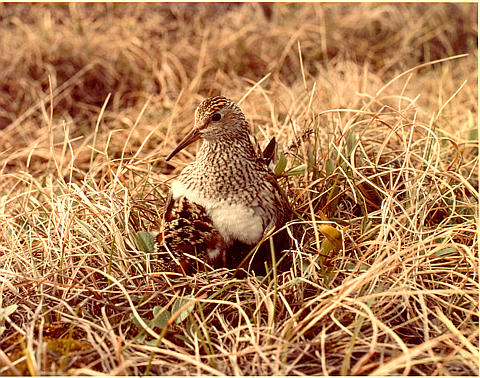
Pectoral Sandpipers nest on the arctic tundra, often near water. The nest is lined with grass, moss and lichens. Typical clutch size is 4 eggs. Photo source: http://picturethis.pnl.gov/picturet.nsf/f/uv?open&SMAA-497TFH |

White-throated Kingfisher
Spacing of Bank Swallow tunnel entrances
(Ghent 2001) -- Tunnel entrance distributions at six Bank Swallow sand-pit
colonies showed consistently nonrandom, too-regular patterns, supporting
the hypothesis that the distance between tunnel entrances is determined
by territorial disputes at the tunnel  mouths.
Average nearest neighbor distances, and numbers of burrows per unit area
of pit face, were both consistently greater than their random expectations,
a paradox that is explained algebraically. Evidence of tunnel coalescence
and communal nesting was found in a completely evacuated colony of 30 tunnels.
Bank Swallow colonial behaviors may have evolved to maximize populations
on small exposed bank faces along streams and rivers, and that they are
still behaving as if only small fractions of large sand pit banks are available.
On small areas, regular spacings help to avoid too close tunneling and
concomitant bank collapse. It is argued that a tolerance for communal nesting,
once coalescence has occurred, involves less tunneling than the forced
evacuations of entirely new tunnels by ousted pairs. mouths.
Average nearest neighbor distances, and numbers of burrows per unit area
of pit face, were both consistently greater than their random expectations,
a paradox that is explained algebraically. Evidence of tunnel coalescence
and communal nesting was found in a completely evacuated colony of 30 tunnels.
Bank Swallow colonial behaviors may have evolved to maximize populations
on small exposed bank faces along streams and rivers, and that they are
still behaving as if only small fractions of large sand pit banks are available.
On small areas, regular spacings help to avoid too close tunneling and
concomitant bank collapse. It is argued that a tolerance for communal nesting,
once coalescence has occurred, involves less tunneling than the forced
evacuations of entirely new tunnels by ousted pairs.
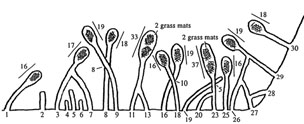
Excavation of 30 tunnels. Three of the five coalescing groups led to double-length nest chambers with two grass-mat nests. Vertical separations (e.g., 8 cm between tunnels 8 and 9) indicate where neighboring tunnels crossed w/out coalescing. |

Area A = 4.26 sq. m determined by visual framing of a too regularly spaced burrows of a Bank Swallow colony. A' = 7.37 sq. m is the area on which 27 (solid circle) burrows leading to a nest would have to be distributed to equate their observed average nearest neighbor distance r to its random expectation E[r]. Open circles represent 6 tunnels not leading to a nest (not included in the calculations) |
Mites and birds -- At least 2500 species of mites from 40 families are closely associated with birds, occupying all conceivable habitats in the nests and on the bodies of their hosts. No avian taxon is free from a mite associate because even those that lack feather mites, such as penguins, are attacked by ticks. Bird mites can be divided into those that dwell primarily in, or near, the nest and those that reside mainly on the body of the host. The best studied nest-dwelling mites are blood feeders from the genera
Dermanyssus 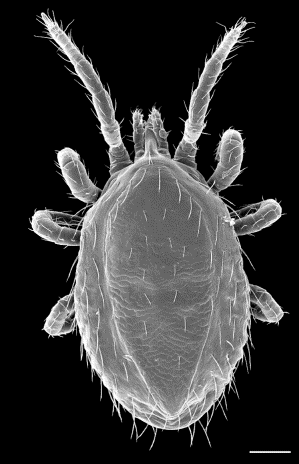 and Ornithonyssus (shown here is a micrograph of a female Ornithonyssus bursa, a common nest parasite of passerines. Scale bar = 100 μm. Micrograph from Dave Walter, University of Queensland). Depending on the species involved, adults of these blood feeders live in the nest or on the hosts, but nymphal stages are primarily nestbound and only visit hosts when they need to feed. These mites have short generation times and can rapidly build-up huge populations. For example, half a million northern fowl mites have been extracted from a single nest. Ticks can also be temporary nest parasites. Soft ticks visit the host at night, feed for a few minutes and then retreat to a refuge in, or near, the nest. Hard ticks tend not to be so nestbound and will attack birds as they brush against vegetation during foraging or resting. However, not all nest mites are parasitic. Relatives of human-associated ‘dust mites’ feed on the dermal detritus that sifts down into the nest material. Other nest dwelling mites prey on blood-sucking mites, and thus might act as mutualists.
and Ornithonyssus (shown here is a micrograph of a female Ornithonyssus bursa, a common nest parasite of passerines. Scale bar = 100 μm. Micrograph from Dave Walter, University of Queensland). Depending on the species involved, adults of these blood feeders live in the nest or on the hosts, but nymphal stages are primarily nestbound and only visit hosts when they need to feed. These mites have short generation times and can rapidly build-up huge populations. For example, half a million northern fowl mites have been extracted from a single nest. Ticks can also be temporary nest parasites. Soft ticks visit the host at night, feed for a few minutes and then retreat to a refuge in, or near, the nest. Hard ticks tend not to be so nestbound and will attack birds as they brush against vegetation during foraging or resting. However, not all nest mites are parasitic. Relatives of human-associated ‘dust mites’ feed on the dermal detritus that sifts down into the nest material. Other nest dwelling mites prey on blood-sucking mites, and thus might act as mutualists.
Blood-feeding nest mites can reduce the reproductive success of their hosts by slowing development or even killing chicks. For example, recent experimental work has shown that high densities of nest mites are associated with low hematocrit and small body size in Pied Flycatchers (Ficedula hypoleuca), and low hatching success and postfledging survival in Rock Pigeons (Columba livia) and Barn Swallows (Hirundo rustica). By contrast, however, Darolová et al. (1997) observed a positive association between the percentage of Penduline Tit (Remiz pendulinus) nestlings that survived to fledging and the number of hematophagous mites in the nest. The authors suggest that nestling health determines mite load rather than vice versa. Other researchers have found no relationship between nest–parasite density and nesting success. Merino and Potti (1996) suggested that variable effects of nest parasites are, in part, a result of stochastic climatic factors, such as temperature and rainfall. More work is required to establish why the effects of nest mites on host reproductive success are so variable across studies. -- Proctor and Owens (2000).
Pileated Woodpecker nest cavity
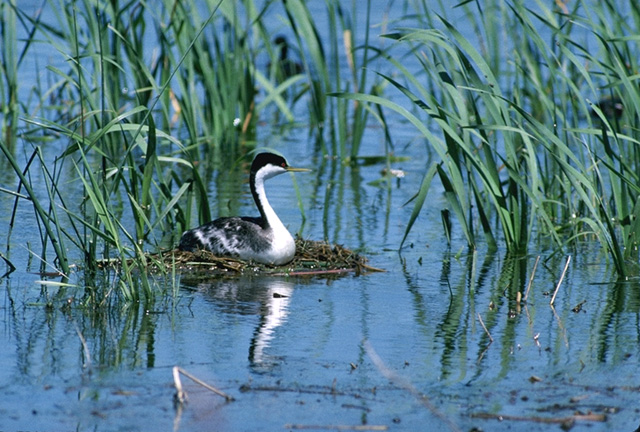
Common Buzzard (Buteo buteo) nest
Uncovering the hidden world of a secretive seabird (Marbled Murrelet) by Jim Rivers

Bird nests vary from a simple accumulation of materials on the ground to elaborate refuges in or on secluded & elevated substrates. Dial (2003) observed that nest construction and placement are correlated with other features such as flight ability. For example, basal avian taxa (ratites & many Galliformes) create a simple depression in the ground to harbor their incubating eggs, like those of nonavian dinosaurs. The progression of nest complexity moves from cryptic ground nests of some galliforms to simple elevated nests (e.g., Columbiformes, Cuculiformes, & Ciconiiformes). Taxa that construct elevated nests in a bush or tree or on a cliff or rock ledge tend to be better fliers than simple ground nesters.Young raised in elevated & cavity nests, including primary (Psittaciformes, Piciformes, & Coraciformes) and secondary (many Passeriformes) cavity nesters, have a robust forelimb flight apparatus, and less hindlimb mass, which is consistent with increasing flight capacity. As nest placement (e.g. invisibility, inaccessibility), construction (e.g. impregnability, camouflage), and attendance (e.g. feeding, protection, incubation) increase in complexity, a concomitant enhancement of flight styles is observed, including maneuverability and acceleration. The most complex nests are associated with some Passeriformes, particularly swallows, oropendolas, and weaver finches. Weaver finches (Ploceidae, Passeridae) and oropendolas (Icteridae) build intricately woven chambered, pendant nests hung from the resilient thin branches of bushes and trees in predator-rich environments. Perhaps the most predator-proof nests are those of swallows (Hirundinidae) and swifts (Apodidae) that often construct mud encasements secured to the most remote overhanging feature within their habitat (e.g. cliffs and human-made structures) (Dial 2003). |
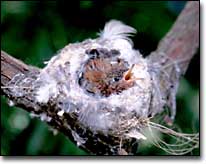
Source: http://www.sandiegozoo.org/wildideas/animal/hummingbird.html
Rufous-tailed Hummingbird (Costa Rica)

Nest surface area and nest predation rates for 36 altricial bird species
studied in tropical Venezuela
and temperate Arizona. Nest predation
increased with nest surface area at both
field sites.
Nest size and nest predation -- Latitudinal variation in clutch sizes of birds is a well described, but poorly understood pattern. Many hypotheses have been proposed, but few have been experimentally tested, and none have been universally accepted by researchers. The nest size hypothesis posits that higher nest predation in the tropics favours selection for smaller nests and thereby constrains clutch size by shrinking available space for eggs and/or nestlings in the nest. Biancucci and Martin (2010) tested this hypothesis with an experiment in a tropical forest and a comparative study between temperate and tropical field sites and, specifically, tested if: (i) predation rates increased with nest size, (ii) tropical birds had smaller nests controlled for body size, and (iii) clutch size was explained by nest size controlled for body size. Experimental swapping of nests of different sizes showed that nest predation increased with nest size in the tropical site. Moreover, nest predation rates were higher in species with larger nests at both sites. However, nest size, corrected for body mass and phylogeny, did not differ between sites and was not related to clutch size between sites. Hence, nest predation can exert selection on nest size as predicted by the hypothesis. Nest size increased with adult body mass, such that adult size might indirectly influence reproductive success through effects on nest size and nest predation risk. Ultimately, however, selection from nest predation on nest size does not explain the smaller clutch sizes typical of the tropics.
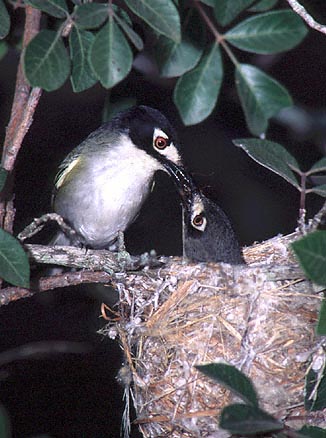
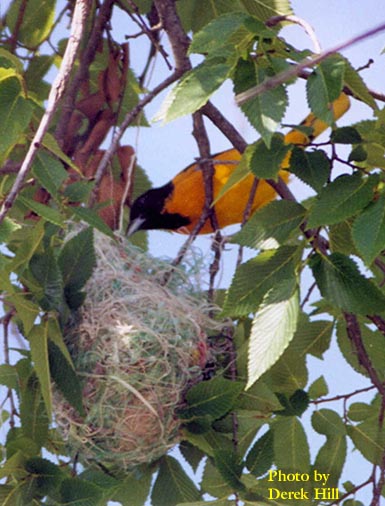
Oropendola nests
Baya Weavers (Ploceus phillipinus) nest in colonies of up to 20-30 pairs, usually in trees near freshwater and open ground.
Their nests hang from a branch and look like an upside-down flask. A long tube leads to a side entrance, making
it difficult even for snakes to enter the nest. Nests are made entirely out of strips of grass that the birds collect by cutting
a notch
in some
tall grass, then stripping off a 30-60 cm long piece.
A newly-made nest is green with fresh grass and turns
brown as the grass dries.
A bird may make up to 500 trips to complete a nest.
Hummingbird nest
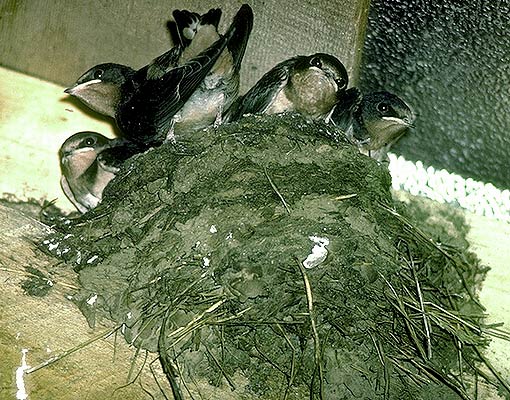
Chimney Swift using saliva as glue to help support its nest.
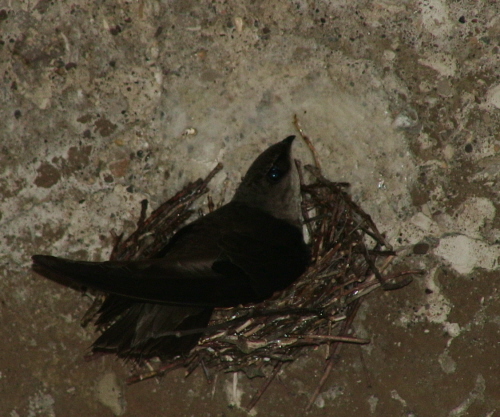
Saliva 'solidified' and forming arch over Chimney Swift nest to help hold it against the wall.
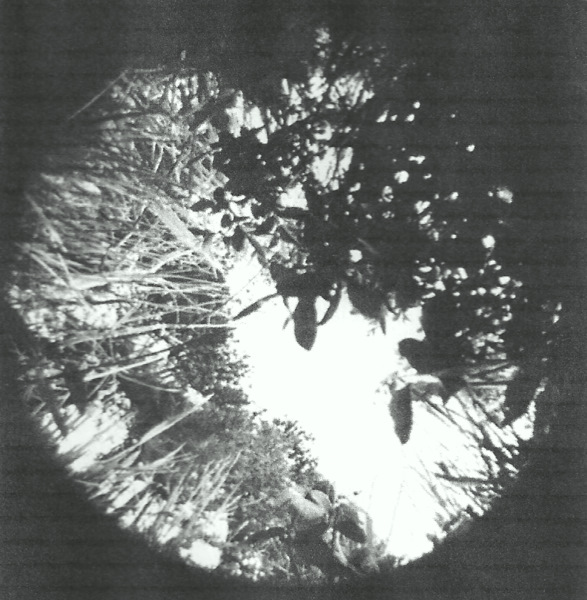
Hemispherical photo of the vegetative canopy over a White-crowned Sparrow nest. Nests often have less vegetative cover in the
eastern sky, allowing more solar radiation to strike nests in the morning when ambient temperatures are cooler (From: Walsberg and King 1978).
Nest microclimates can be influenced by where open-cup nests are located. Shrub-nesting White-crowned Sparrows (Zonotrichia leucophrys) appear to consider the vegetation canopy when determining where to build nests. Walsberg and King (1978) examined the distribution of vegetation located above nests at a high-altitude site (1890 m) in Oregon and found that most nests were positioned so that they were more exposed to sunlight (75% more on average) in the morning when ambient temperatures were lower than the afternoon when temperatures were higher. This difference in exposure to solar radiation likely helped warm nests and their contents during cool mornings and reduced the likelihood of overheating during warmer afternoons.

Typical nest location for a female Broad-tailed Hummingbird with a branch above the nest serving as a ‘roof’ (From: Calder 1973).
Nest microclimates may, in some cases, be as important for adult birds as for embryos and nestlings. Some hummingbirds nest at high latitude and high altitude locations where the combination of their high metabolic rates and sometimes cool ambient temperatures (particularly at night) may make balancing energy budgets difficult. Incubating and brooding female hummingbirds can, of course, conserve energy at night by entering torpor. However, even after allowing their body temperatures to drop, hummingbirds may still lose heat via radiation when ambient temperatures are lower than their body temperature. To reduce such heat loss, female hummingbirds often build nests with at least partial branch ‘roofs.’ Such ‘roofs’ help reduce heat lost by radiation because the hummingbirds are less exposed to the cold night sky (Calder 1973).
| Tits weave fragrant nests. - Birds weave aromatic plants into their nests, apparently to keep their home clean and bug-free for raising chicks. Blue Tits on the fragrant Mediterranean island of Corsica can even smell when it's time to refresh fading fragments, ecologists have shown (Petit et al. 2002). Female blue tits gather lavender, yarrow, curry, mint and other scented plants for their nests shortly after laying eggs, and continue to do so until the chicks leave home. "They are real botanists and do a great job exploiting their environment to protect their chicks," says Marcel Lambrechts of the Centre for Functional Ecology and Evolution in Montpellier, France. The birds make a pot-pourri of 10 aromatic plants from the 250 species in their habitat. Many of the chemicals in these plants ward off bacteria, viruses, parasites, fungi and insects. Lambrechts's team removed the aromatic plants from 64 nests and then placed a hidden box containing lavender and yarrow underneath half of the nests. In the first 24 hours, only the birds with empty boxes replenished their herb supply. After 48 hours, the other half of the birds began to restock too, as the scent from the hidden herbs waned. "This field test directly shows that birds are attending to odour cues," says Larry Clark, who studies similar behaviour in European Starlings at the National Wildlife Research Center in Fort Collins, Colorado. The Blue Tits select for chemical diversity as well as high concentrations of chemicals, he points out, underlining the importance of olfaction in avian behavior. -- Kendall Powell, Nature Science Update | 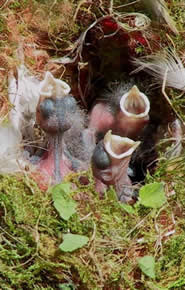
|
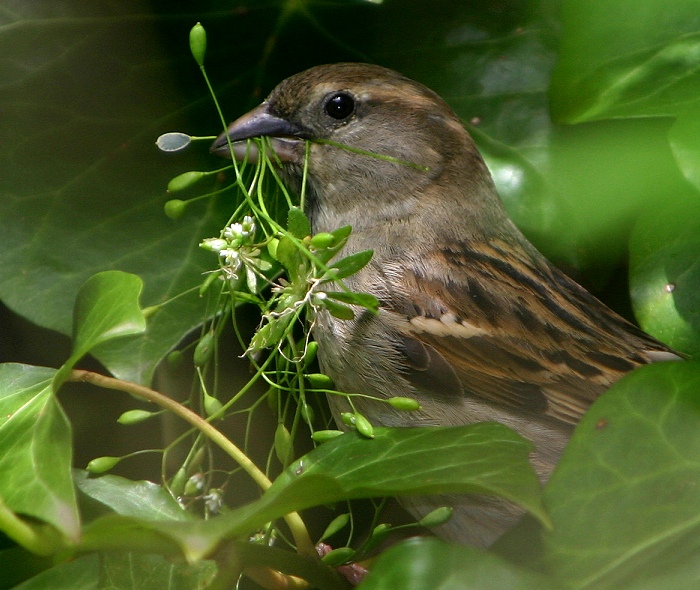
Denmark/photo59174.htm |
Birds Use Herbs To Protect Their Nests Researchers from Ohio Wesleyan University suggest that some birds may select nesting material with antimicrobial agents to protect their young from harmful bacteria. They presented their findings at the 2004 meeting of the American Society for Microbiology. "If the fresh herbs and plant materials that parent birds bring into the nest have a sufficient concentration of antimicrobial compounds, they could protect the nestlings from harmful bacteria," says researcher Jann Ichida. To find out if plants brought into the nest might prevent disease, Ichida and colleagues tested 12 different volatile plant materials against feather-degrading bacteria. Results showed that several types of plant materials and extracts including usnic acid, ascorbic acid, yarrow, and two oak species inhibited the growth of a number of harmful bacteria. "If the fresh herbs have a sufficient concentration of these chemicals, they could protect the nestlings from harmful bacteria," says Ichida. "By practicing medical botany, parent birds exercise effective home nest security and protect their offspring from select biodegrading microbes that affect the health of their young." - Science Daily |
| Using scat to reduce nest predation -- For many animals, nest construction is a prerequisite for successful breeding. The choice of nesting materials is an important component of nest construction, because material properties can influence nest design and, potentially, reproductive success. Common Waxbills are small African finches that select carnivore scat as a material to include in, on, and around their nests. Schuetz (2005) investigated the hypothesis that scat functions to reduce predation risk by documenting its use in a wild population of Common Waxbills and by conducting an artificial nest experiment. Among natural nests, scat was present in every nest that hatched young, and parents continued to add scat to nests throughout the nestling period. Among artificial nests, those that received experimental additions of carnivore scat survived at a significantly higher rate than did untreated nests, suggesting that scat functions to reduce predation risk. The mechanism by which nests are protected remains unclear, although it is likely that scat acts as an olfactory deterrent and/or camouflage. Researchers have long focused on the implications of nest site characteristics for avian life-history evolution. Results of the present study suggest that nest materials, similar to nest sites, may influence life histories of nest-building animals by affecting predation risk. |
|
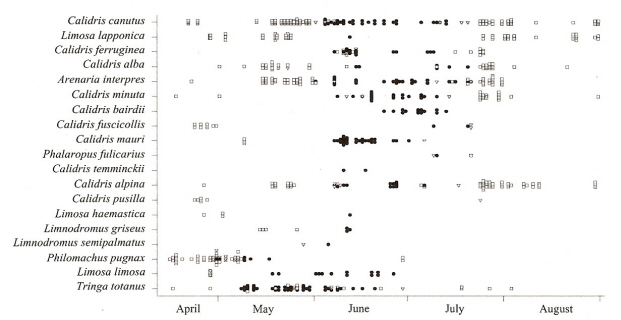
Seasonal changes in chemical composition of preen waxes of adults in 19 species of sandpipers. Species are listed from
top to bottom
on the basis of median latitude of their breeding range, with the northernmost species first. Squares = monoesters,
triangles = mixture of mono- and diesters, filled circles = diesters (From: Reneerken et al. 2002).
Nest construction
Few studies have focused on the question of whether nest building by birds in an innate behavior or is, at least to some extent, learned. Two lines of evidence suggest that nest building has a large instinctive component: (1) the structure and composition of nests exhibit little intraspecific variation, and (2) birds raised in isolation tend to build species-specific nests. However, particularly for birds that build more complex nests, evidence indicates that birds learn by experience and, as a result, the quality of nests built by older birds may exceed that of nests built by younger, less experienced birds. For example, the first nests of young male Village Weavers (Ploceus cucullatus) are more loosely and crudely constructed than nests built by more experienced males.

Left, nest built by older, experienced male Village Weaver and, right, the first nest built by a young male
(Collias and Collias 1964).
Another way of examining the extent to which nest building is innate versus learned is to determine the degree of repeatability of nest morphology, with greater repeatability indicating a behavior with a greater genetic component. Among some species of birds, nest morphology has been found to be very repeatable. For example, Barn Swallows (Hirundo rustica) build cup-shaped nests using mud and straw. Characteristics of the nests of individual swallows were found to be consistent both within and between years and, in addition, the characteristics of nests were even similar across generations, suggesting that nest building by Barn Swallows has a heritable component and is a largely instinctive behavior (Møller 2006). Similarly, the nests of individual Penduline Tits (Remiz pendulinus) exhibit little variation across seasons (Schleicher et al. 1996). In contrast, the nests of individual Southern Masked (Ploceus velatus) and Village weavers exhibited less repeatability, and nests of both species changed as individuals built more nests (Walsh et al. 2010; Figure below). Such results suggest that, for many species of birds, nest building is primarily if not entirely instinctive. However, at least for species that build more complex nests, such as weavers (Ploceidae), nest construction involves both instinct (especially for first nests) and learning.
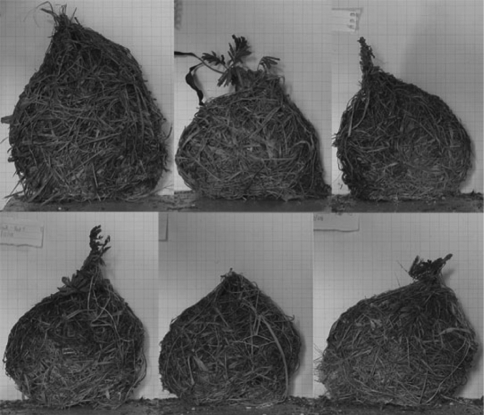
A series of six nests built by a male Southern Masked Weaver (first nest, upper left,
and last nest, lower right) (From: Walsh et al. 2010).
Weavers
The time needed to build a nest varies with the complexity of the nest and other factors such as time of year and weather. In temperate areas, construction of the first nest of the breeding season may take longer than nests later in the season (particular in resident species like Eastern Bluebirds and Northern Cardinals). Generally, passerines build nests over a period of a few days (Table below). Construction of the nests of some larger birds, such as raptors, may require as long as several weeks. Woodpeckers excavate nest cavities in tree trunks or branches, a process that, for species found in North America, typically takes anywhere from 6 to 36 days (Table below).
Time needed for representative songbirds to complete their open-cup nests.
Species |
Typical time to |
Reference |
Least Flycatcher |
5 – 7 days |
Tarof and Briskie 2008 |
Loggerhead Shrike |
6 – 11 days |
Yosef 1996 |
White-eyed Vireo |
3 – 5 days |
Hopp et al. 1995 |
Clark’s Nutcracker |
5 – 8 days |
Tomback 1998 |
Verdin |
about 6 days |
Webster 1999 |
Cactus Wren |
1 – 6 days |
Proudfoot et al. 2000 |
Black-tailed Gnatcatcher |
2 – 4 days |
Farquhar and Ritchie 2002 |
Ruby-crowned Kinglet |
about 5 days |
Swanson et al. 2008 |
Northern Wheatear |
2 – 7 days |
Kren and Zoerb 1997 |
American Robin |
5 – 7 days |
Sallabanks and James 1999 |
Gray Catbird |
5 – 6 days |
Smith et al. 2011 |
Cedar Waxwing |
3 – 9 days |
Witmer et al. 1997 |
Yellow Warbler |
4 – 10 days |
Lowther et al. 1999 |
Eastern Towhee |
up to 5 days |
Greenlaw 1996 |
Chipping Sparrow |
2 – 8 days |
Middleton 1998 |
Scarlet Tanager |
2 – 7 days |
Mowbray 1999 |
Northern Cardinal |
3 – 9 days |
Halkin and Linville 1999 |
Indigo Bunting |
2 – 10 days |
Payne 2006 |
Red-winged Blackbird |
3 days |
Holcomb and Twiest 1968 |
Orchard Oriole |
6 days |
Scharf and Kren 2010 |
Pine Siskin |
5 - 6 days |
Dawson 1997 |
Time needed for representative woodpeckers to create nest cavites.
Species |
Typical time to |
Reference |
Black-backed Woodpecker |
21 – 28 days |
Dixon and Saab 2000 |
Downy Woodpecker |
7 – 20 days |
Ritchison 1999 |
Golden-fronted Woodpecker |
6 – 12 days |
Husak and Maxwell 1998 |
Hairy Woodpecker |
7 – 21 days |
Bent 1939 |
Pileated Woodpecker |
21 – 36 days |
Bull and Jackson 2011 |
Red-bellied Woodpecker |
~14 days |
Shackelford et al. 2000 |
Red-headed Woodpecker |
12 – 17 days |
Smith et al. 2000 |
White-headed Woodpecker |
21 – 28 days |
Garrett et al. 1996 |
AOS21-(230702) Sex-specific contributions to nest building in birds from American Ornithological Society on Vimeo.
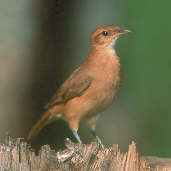
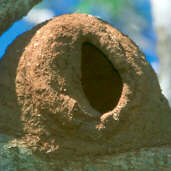

Birds are capable of grand engineering feats. But are they engineers? Not in the way you might think. Just as birds know how to fly, they know how to build a nest without instructions or apprenticeship. It's a matter of instinct. "They are 'hard-wired,' " Causey says, "sort of like robots." Birds craft their nests without consciously thinking about it. How then did some species of birds develop such well-engineered, elaborate nests? One possible explanation involves natural variation and evolution. If a particular bird happens to build a nest that is stronger or more predator-safe, that bird's offspring are more likely to survive and pass along this trait to succeeding generations. Another possibility is that when females choose mates based on the quality of the nests they build, this means the best nest builders are more likely to breed. Nest-building, therefore, may still be evolving, but so slowly that no one really detects any change. This makes nest-building one of the most difficult bird behaviors to understand.
Generally, in temperate areas, nest-building coincides with the arrival of spring. That's when birds' internal "clocks" tell them it's time to mate and raise a brood. In the tropics, though, some birds build nests and breed year-round. The nest, of course, is where females lay eggs and brood young. Which bird actually does the building the male or female varies by species. In some cases, both collect material to build the nest and join in its construction. One of the more peculiar routines is that of the male Marsh Wren (Cistothorus palustris), which migrates north before the female and builds as many as 10 dummy nests in his territory. These dummy nests are not lined with soft materials; lining is added by the female only to the chosen nest. Dummy nests have been shown to have adaptive importance, with active nests built near larger numbers of dummy nests being more successful than those near fewer dummy nests (Leonard and Picman 1987).
We usually think of nests in tree branches. But some birds build nests on the ground, some in bushes. Others might attach their nests to the sides of cliffs. Barn Swallows have an affinity for barns. Chimney Swifts, as the name implies, favor chimneys and other man-made enclosures. Carolina Wrens will nest in almost any cavity, from an empty can to a coat pocket. To keep nests together and secured in place, birds need good adhesives. They use a variety of natural substances to do the job, including mud, saliva, spiderwebs, caterpillar silk, leaf mold, and certain plant fibers. Materials that make up the nest are intertwined, and with the weaver bird, are actually woven or thatched together using grass, strips of leaves, and twigs.
Birds can make hundreds of trips to collect materials. And while they seem to prefer natural objects (helpful as camouflage), some use almost anything that works and that they can carry. Candy wrappers, cellophane, shredded money even barbed wire have shown up in nests. But however coarse the outside of the nest is, the inside is usually lined with soft materials to make it comfy.
One theory about why birds build open nests is that they had to. Larger species shooed them out of the tree holes. Birds intent on avoiding bullies and predators may build nests that have coverings or that hang from the end of tree branches. Less aggressive birds may even build near more aggressive species, for protection. Although some large birds (eagles, hawks, and sea birds) return to nests they've made, most birds rarely do. Eagles may return annually to the huge platform nests they build in the treetops. Some measure as much as 6 feet in diameter. On the flip side are hummingbirds, which fashion tiny cup-like nests not much bigger than a thimble.
Nest-collecting was popular from about 1870 to 1920, says Douglas Causey, ornithologist at Harvard University. Most of the nests in the museum's collection date to that period. Back then, collectors didn't have the ecological awareness that people have today. They would climb trees and saw off branches to "collect" a nest with its eggs intact. Once museums had at least one of each, searching for more made no sense. From about 1920 to 1970, nest and egg collections gathered dust. "They just took up space, and no one knew what to do with them," Causey says. Some were thrown away. During the 1970s, though, interest in bird eggs came back. Scientists noticed that eggshells of some birds had become thinner and more breakable. The insecticide DDT was found to be the cause. Researchers compared the thickness of old eggshells with new. Their findings helped persuade Congress to ban the pesticide. Without eggs from 100 years ago, no comparisons could have been made. Egg and nest collections are important time capsules. They tell of environmental conditions at particular times. This, Causey says, is a good reason to collect more today. Researchers are now examining the old plant material in nests to determine how much carbon monoxide was in the atmosphere decades ago.
In the United States, it is unlawful to collect the nests of migratory birds, unless for approved scientific study. Although not strictly enforced, the law exists to protect birds in the wild from disturbance. When ornithologists study a nest, they know that if it has been unattended for several days, it's usually safe to conclude that the birds have gone and won't be back. -- Ross Atkin (Copyright © 2002 The Christian Science Monitor).
Literature Cited:
Bent, A. C. 1939. Life histories of North American woodpeckers. U.S. National Museum Bulletin 174, Washington, D.C.
Biancucci, L., and T. E. Martin. 2010. Can selection on nest size from nest predation explain the latitudinal gradient in clutch size? Journal of Animal Ecology 79: 1086-1092.
Bull, E. L., and J. A. Jackson. 2011. Pileated Woodpecker ( Dryocopus pileatus). In: The Birds of North America Online (A. Poole, ed.). Cornell Lab of Ornithology, Ithaca, NY; Retrieved from the Birds of North America Online: http://bna.birds.cornell.edu/bna.html/species/148
Calder, W. A. 1973. Microhabitat selection during nesting of hummingbirds in the Rocky Mountains. Ecology 54: 127-134.
Chiappe, L. M. 2009. Downsized dinosaurs: the evolutionary transition to modern birds. Evolution: Education and Outreach 2:248-256.
Collias, E. C., and N. E. Collias. 1964. The development of nest-building behavior in a weaverbird. Auk 81: 42-52.
Darolova, A., H. Hoi, and B. Schleicher. 1997. The effect of ectoparasite nest load on the breeding biology of the Penduline Tit Remiz pendulinus. Ibis 139: 115-120.
Dawson, W. R. 1997. Pine Siskin ( Spinus pinus). In: The Birds of North America Online (A. Poole, ed.). Cornell Lab of Ornithology, Ithaca, NY; Retrieved from the Birds of North America Online: http://bna.birds.cornell.edu/bna.html/species/280
Dial, K. P. 2003. Evolution of avian locomotion: correlates of flight style, locomotor modules, nesting biology, body size, development,and the origin of flapping flight. Auk 120:941-952.
Dixon, R. D., and V. A. Saab. 2000. Black-backed Woodpecker ( Picoides arcticus). In: The Birds of North America Online (A. Poole, ed.). Cornell Lab of Ornithology, Ithaca, NY; Retrieved from the Birds of North America Online: http://bna.birds.cornell.edu/bna.html/species/509
Farquhar, C. C., and K. L. Ritchie. 2002. Black-tailed Gnatcatcher ( Polioptila melanura). In: The Birds of North America Online (A. Poole, ed.). Cornell Lab of Ornithology, Ithaca, NY; Retrieved from the Birds of North America Online: http://bna.birds.cornell.edu/bna.html/species/690
Garrett, K. L., M. G. Raphael and R. D. Dixon. 1996. White-headed Woodpecker ( Picoides albolarvatus). In: The Birds of North America Online (A. Poole, ed.). Cornell Lab of Ornithology, Ithaca, NY; Retrieved from the Birds of North America Online: http://bna.birds.cornell.edu/bna.html/species/252
Ghent, A.W. 2001. Regular spatial patterns of Bank Swallow (Riparia riparia) tunnel entrances, with some possible evolutionary implications. American Midland Naturalist 146: 414-423.
Greenlaw, J. S. 1996. Eastern Towhee ( Pipilo erythrophthalmus). In: The Birds of North America Online (A. Poole, ed.). Cornell Lab of Ornithology, Ithaca, NY; Retrieved from the Birds of North America Online: http://bna.birds.cornell.edu/bna.html/species/262
Halkin, S. L., and S. U. Linville. 1999. Northern Cardinal ( Cardinalis cardinalis). In: The Birds of North America Online (A. Poole, ed.). Cornell Lab of Ornithology, Ithaca, NY; Retrieved from the Birds of North America Online: http://bna.birds.cornell.edu/bna.html/species/440
Hartman, C.A. and L. W. Oring. 2003. Orientation and microclimate of Horned Lark nests: the importance of shade. Condor 105:158-163.
Holcomb, L. C., and G. Twiest. 1968. Ecological factors affecting nest building in Red-winged Blackbirds. Bird-Banding 39: 14-22.
Hopp, S. L., A. Kirby, and C. A. Boone. 1995. White-eyed Vireo ( Vireo griseus). In: The Birds of North America Online (A. Poole, ed.). Cornell Lab of Ornithology, Ithaca, NY; Retrieved from the Birds of North America Online: http://bna.birds.cornell.edu/bna.html/species/168
Husak, M. S., and T. C. Maxwell. 1998. Golden-fronted Woodpecker ( Melanerpes aurifrons). In: The Birds of North America Online (A. Poole, ed.). Cornell Lab of Ornithology, Ithaca, NY; Retrieved from the Birds of North America Online: http://bna.birds.cornell.edu/bna.html/species/373
Kren, J., and A. C. Zoerb. 1997. Northern Wheatear ( Oenanthe oenanthe). In: The Birds of North America Online (A. Poole, ed.). Cornell Lab of Ornithology, Ithaca, NY; Retrieved from the Birds of North America Online: http://bna.birds.cornell.edu/bna.html/species/316
Leonard, M.L. and J. Picman. 1987. The adaptive significance of multiple nest building by male Marsh Wrens. Animal Behaviour 35:271-277.
Lowther, P. E., C. Celada, N. K. Klein, C. C. Rimmer and D. A. Spector. 1999. Yellow Warbler ( Dendroica petechia). In: The Birds of North America Online (A. Poole, ed.). Cornell Lab of Ornithology, Ithaca, NY; Retrieved from the Birds of North America Online: http://bna.birds.cornell.edu/bna.html/species/454
Merino, S. and J. Potti. 1996. Weather dependent effects of nest ectoparasites on their bird hosts. Ecography 19: 107–113.
Middleton, A. L. 1998. Chipping Sparrow ( Spizella passerina). In: The Birds of North America Online (A. Poole, ed.). Cornell Lab of Ornithology, Ithaca, NY; Retrieved from the Birds of North America Online: http://bna.birds.cornell.edu/bna.html/species/334
Møller, A. P. 2006. Rapid change in nest size of a bird related to change in a secondary sexual character. Behavioral Ecology 17: 108-116.
Mowbray, T. B. 1999. Scarlet Tanager ( Piranga olivacea). In: The Birds of North America Online (A. Poole, ed.). Cornell Lab of Ornithology, Ithaca, NY; Retrieved from the Birds of North America Online: http://bna.birds.cornell.edu/bna.html/species/479
Myers, P., R. Espinosa, C. S. Parr, T. Jones, G. S. Hammond, and T. A. Dewey. 2005. The Animal Diversity Web (online). Accessed November 27, 2005 at http://animaldiversity.org.
Payne, R. B. 2006. Indigo Bunting ( Passerina cyanea). In: The Birds of North America Online (A. Poole, ed.). Cornell Lab of Ornithology, Ithaca, NY; Retrieved from the Birds of North America Online: http://bna.birds.cornell.edu/bna.html/species/004
Petit, C., M. Hossaert-McKey, P. Perret, J. Blondel & M.M. Lambrechts. 2002. Blue Tits use selected plants and olfaction to maintain an aromatic environment for nestlings. Ecology Letters 5: 585 - 589.
Pettingill, O.S., Jr. 1985. Ornithology in Laboratory and Field, Fifth ed. Academic Press, New York, NY.
Proctor, H. and I. Owens. 2000. Mites and birds: diversity, parasitism and coevolution. Trends in Ecology and Evolution 15: 358–364.
Proudfoot, G. A., D. A. Sherry, and S. Johnson. 2000. Cactus Wren ( Campylorhynchus brunneicapillus). In: The Birds of North America Online (A. Poole, ed.). Cornell Lab of Ornithology, Ithaca, NY; Retrieved from the Birds of North America Online: http://bna.birds.cornell.edu/bna.html/species/558
Reneerkens, J., T. Piersma, J. S. Sinninghe Damsté. 2002. Sandpipers (Scolopacidae) switch from monoester to diester preen waxes during courtship and incubation, but why? Proc. Roy. Soc. Lond. B 269: 2135-2139.
Scharf, W. C., and J. Kren. 2010. Orchard Oriole ( Icterus spurius). In: The Birds of North America Online (A. Poole, ed.). Cornell Lab of Ornithology, Ithaca, NY; Retrieved from the Birds of North America Online: http://bna.birds.cornell.edu/bna.html/species/255
Smith, K. G., J. H. Withgott, and P. G. Rodewald. 2000. Red-headed Woodpecker ( Melanerpes erythrocephalus). In: The Birds of North America Online (A. Poole, ed.). Cornell Lab of Ornithology, Ithaca, NY; Retrieved from the Birds of North America Online: http://bna.birds.cornell.edu/bna.html/species/518
Tomback, D. F. 1998. Clark's Nutcracker ( Nucifraga columbiana). In: The Birds of North America Online (A. Poole, ed.). Cornell Lab of Ornithology, Ithaca, NY; Retrieved from the Birds of North America Online: http://bna.birds.cornell.edu/bna.html/species/331
Walsh, P. T., M. Hansell, W. D. Borello, and S. D. Healy. 2010. Repeatability of nest morphology in African weaver birds. Biology Letters 6: 149-151.
Webster, M. D. 1999. Verdin ( Auriparus flaviceps). In: The Birds of North America Online (A. Poole, ed.). Cornell Lab of Ornithology, Ithaca, NY; Retrieved from the Birds of North America Online: http://bna.birds.cornell.edu/bna.html/species/470
Welty, J.C. and L. Baptista. 1988. The life of birds, fourth ed. Saunders College Publishing, New York, NY.
Witmer, M. C., D. J. Mountjoy and L. Elliot. 1997. Cedar Waxwing ( Bombycilla cedrorum). In: The Birds of North America Online (A. Poole, ed.). Cornell Lab of Ornithology, Ithaca, NY; Retrieved from the Birds of North America Online: http://bna.birds.cornell.edu/bna.html/species/309
Yosef, R. 1996. Loggerhead Shrike ( Lanius ludovicianus). In: The Birds of North America Online (A. Poole, ed.). Cornell Lab of Ornithology, Ithaca, NY; Retrieved from the Birds of North America Online: http://bna.birds.cornell.edu/bna.html/species/231
More lecture notes:
Avian Reproduction III: Clutch Size, Incubation, & Hatching